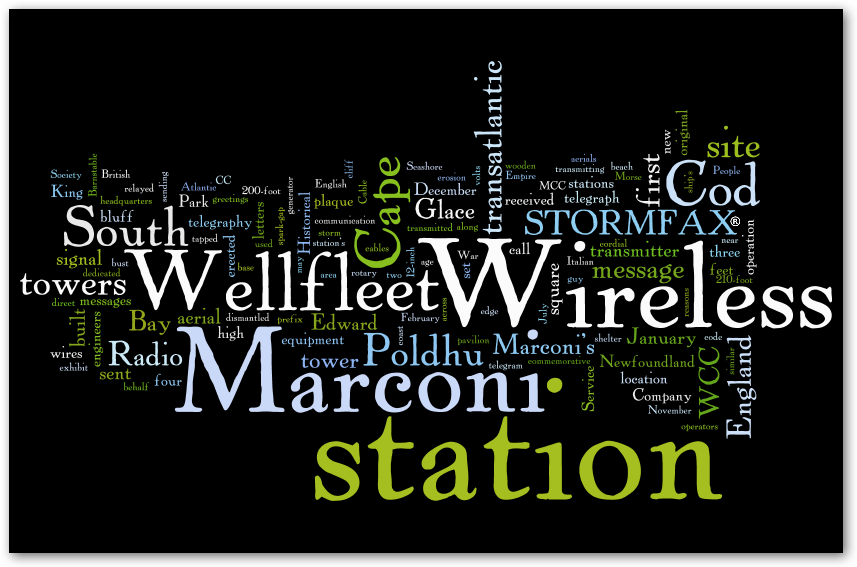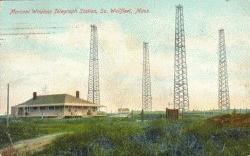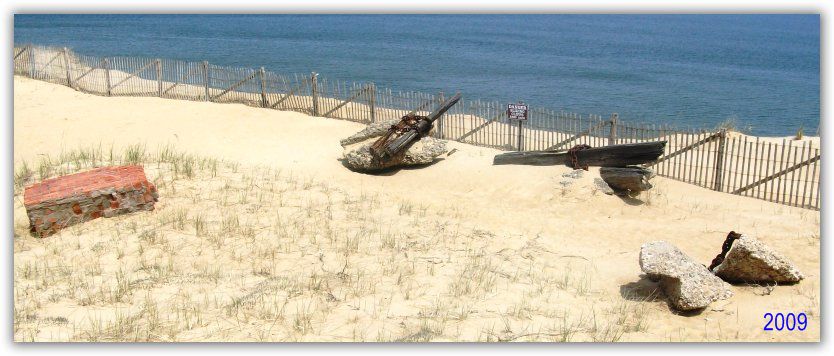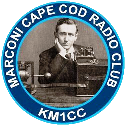



120th Anniversary of "WCC"
Radio pioneer Guglielmo Marconi was an electrical engineer and inventor born in Bologna, Italy on April 25, 1874. At the age of 16, he successfully transmitted wireless telegraph signals between tin plates mounted on posts in his mother's garden. Marconi gradually increased the distance between radio transmitter and receiver. At the age of 23, he couldn't convince the Italian government of the worth of radio. He and his mother traveled to England and demonstrated his invention by sending a signal across the English Channel on March 27, 1899.
Marconi's dream was to send a signal across the Atlantic Ocean.
In 1900, Marconi set up a high-powered transmitting station at Poldhu, on the English coast at Cornwall. In 1901, Marconi built a wireless station at Signal Hill, Newfoundland and on Cape Cod, Massachusetts.
Marconi selected Cape Cod since it had been described by Thoreau as a place "where a man may stand and put all of America behind him." After passing up a location in Barnstable and being denied permission to build his wireless station near the Highland Light, Marconi settled for an eight-acre site on a high bluff in South Wellfleet. Marconi set up headquarters at the Holbrook House in Wellfleet.
The South Wellfleet station was similar to the Poldhu one with a circular series of twenty 200-foot ship's masts set back 165 feet from the edge of the bluff.
Storms blew down the aerials at Poldhu on September 17, 1901 and a Nor'easter toppled the aerials on Cape Cod on November 25th. Nevertheless, Marconi received the first transatlantic signal - the three-dot Morse code letter "S" tapped out from Poldhu on December 12th at the Newfoundland station. The aerial at Poldhu was held aloft by a canvas kite.
Fearing competition from Marconi's wireless, the Anglo American Cable Company ordered Marconi to shut down operations in Newfoundland. On December 22, 1901, the Canadian government offered him a location for a station at Glace Bay, Nova Scotia. A year later, on December 17, 1902, the Glace Bay station was sending and receiving transatlantic messages.

In February, 1902, a new aerial design at the South Wellfleet station was erected with four 210-foot wooden towers in a 200-foot square pattern. Each tower was 24-feet square at the base and 8-feet square at the top. Twelve steel cables, one-inch in diameter, secured each tower against high winds. The guy wires were anchored to 12-inch by 12-inch crossed timbers buried nine feet in the sand. The cables were tightened by giant turnbuckles. To insulate the towers, station engineers used ship's deadeyes between rubber hoses and manila rope with melted sulphur connectors located amid the guy wires. A square 4-foot-thick cement slab was used as a base for each tower. The aerial rigging among the towers was a conical arrangement of 200 wires converging in midair just above the transmitter house and feeding in through a single wire. A similar tower configuration was already in operation at Poldhu and Glace Bay.
Inside the transmitter building was a 20,000-volt condenser, antenna tuning coil, and the rotary spark-gap, the buzz of which could be heard three or four miles away. The transmitter was powered by a 45-horsepower kerosene engine generator supplying 2,200 volts of AC to a transformer that stepped it up to 20,000 volts. A small DC generator charged the batteries.
At the headquarters were a manager, two engineers, and three operators who lived on the site.
Marconi convinced President Theodore Roosevelt to take part in a wireless experiment where a message would be sent from Cape Cod to the King of England.
On January 18, 1903, President Theodore Roosevelt's message was tapped out in Morse code from South Wellfleet to King Edward VII at the Poldhu station. It was to be the first two-way transatlantic communication and the first wireless telegram between America and Europe. The message read:
London, Eng.
In taking advantage of the wonderful triumph of scientific research and ingenuity which has been achieved in perfecting a system of wireless telegraphy, I extend on behalf of the American People most cordial greetings and good wishes to you and to all the people of the British Empire.
THEODORE ROOSEVELT
Wellfleet, Mass., Jan. 19, 1903
The President,
White House, Washington, America
I thank you most sincerely for the kind message which I have just received from you, through Marconi's trans-Atlantic wireless telegraphy. I sincerely reciprocate in the name of the British Empire the cordial greetings and friendly sentiment expressed by you on behalf of the American Nation, I heartily wish you and your country every possible prosperity.
EDWARD R. and I.
The South Wellfleet station proved to be less practical for relaying transatlantic messages than the northern location of the Glace Bay station. However, it served as Marconi's main North American "ship to shore" wireless station. The station was the Cunard liner Lusitania's direct link to America while out at sea. The passengers received daily news reports and sent personal wireless messages called Marconi-grams.

During its 16 years in operation, the South Wellfleet station had three sets of call letters: first CC for Cape Cod, then MCC for Marconi Cape Cod, and finally WCC when eastern US stations all took the "W" prefix.
WCC was shut down in 1917 along with most other American stations for security reasons during World War I. The closing didn't come too soon. The erosion of the outer bank of the cliff undermined the two tower bases close to the edge in 1916, having lost 150 feet of the original 165-foot setback since 1901.
Following WWI, the station was dismantled and the towers taken down in 1920. New radio technology pioneered by Lee DeForest and his vacuum tube doomed wireless telegraphy as commercially obsolete. The operation of WCC was moved to Chatham, became part of RCA's Global Communication Network and employed upgraded equipment as an important ship-to-shore radio station. Marconi died in Rome on July 20, 1937.
The Wellfleet Historical Society placed a bronze plaque near the original site commemorating the station in 1953. It reads:
MARCONI WIRELESS TELEGRAPH COMPANY OF AMERICA
PREDECESSOR OF RCA
TRANSMITTED JANUARY 19, 1903
THE FIRST U.S. TRANSATLANTIC WIRELESS TELEGRAM
ADDRESSED TO
EDWARD VII KING OF ENGLAND
BY
THEODORE ROOSEVELT
PRESIDENT OF THE UNITED STATES.
The National Park Service, as part of the Cape Cod National Seashore, took over administration of the area in 1961 and dedicated a pavilion to the historical site on July 5, 1963.
In 1974, an exhibit shelter was built to house a scale model of the wireless station and a bronze bust of Marconi, along with the commemorative plaque dedicated in 1953.
 1901 - Marconi begins construction of a wireless station on eight acres of land on a high bluff in South Wellfleet.
1901 - Marconi begins construction of a wireless station on eight acres of land on a high bluff in South Wellfleet. 1901 - A storm blows down the station's towers (November 25).
1901 - A storm blows down the station's towers (November 25). 1902 - A new aerial array is erected and supported by four 210-foot wooden towers (February).
1902 - A new aerial array is erected and supported by four 210-foot wooden towers (February). 1902 - Station "CC" (Cape Cod) is operating on 1500 meters.
1902 - Station "CC" (Cape Cod) is operating on 1500 meters. 1903 - Transatlantic wireless message sent from the United States to England (January 19).
1903 - Transatlantic wireless message sent from the United States to England (January 19). 1905 - The Italian square-rigged barque Castagna wrecks in a storm off the beach below the station.
1905 - The Italian square-rigged barque Castagna wrecks in a storm off the beach below the station. 1906 - Marconi's engineers warn that cliff erosion is endangering the station.
1906 - Marconi's engineers warn that cliff erosion is endangering the station. 1908 - Station's call letters become MCC signifying "Marconi (Station) Cape Cod."
1908 - Station's call letters become MCC signifying "Marconi (Station) Cape Cod." 1911 - The call letters become WCC when the prefix "W" is assigned to all Atlantic and Gulf coast stations.
1911 - The call letters become WCC when the prefix "W" is assigned to all Atlantic and Gulf coast stations. 1917 - United States Government closes the station during World War I for security reasons.
1917 - United States Government closes the station during World War I for security reasons. 1920 - Station is dismantled, towers are scrapped, equipment is salvaged, and the buildings are abandoned.
1920 - Station is dismantled, towers are scrapped, equipment is salvaged, and the buildings are abandoned. 1953 - Wellfleet Historical Society dedicates a bronze plaque at the original site.
1953 - Wellfleet Historical Society dedicates a bronze plaque at the original site. 1961 - Site is acquired by National Park Service as part of Cape Cod National Seashore.
1961 - Site is acquired by National Park Service as part of Cape Cod National Seashore. 1963 - Pavilion is erected at the wireless site and the area is named "Marconi Beach."
1963 - Pavilion is erected at the wireless site and the area is named "Marconi Beach." 1974 - An exhibit shelter is built to house a scale model of the wireless station and a bronze bust of Marconi.
1974 - An exhibit shelter is built to house a scale model of the wireless station and a bronze bust of Marconi. 1978 - 75th Anniversary celebrated by the Barnstable Radio Club commemorative station KM1CC ham operators.
1978 - 75th Anniversary celebrated by the Barnstable Radio Club commemorative station KM1CC ham operators. 2003 - 100th Anniversary celebrated with Marconi's daughter, Maria Elettra Marconi, at the Visitor's Center.
2003 - 100th Anniversary celebrated with Marconi's daughter, Maria Elettra Marconi, at the Visitor's Center. 2023 - 120th Anniversary celebrated by the Marconi Cape Cod Radio Club station KM1CC ham operators.
2023 - 120th Anniversary celebrated by the Marconi Cape Cod Radio Club station KM1CC ham operators.
The huge towers, the zapping sounds of the rotary spark-gap and the excitement of wireless contact with a distant listener are gone forever from the dunes of South Wellfleet.


 Please read our Legal Notice and our Privacy Statement.
Please read our Legal Notice and our Privacy Statement.


